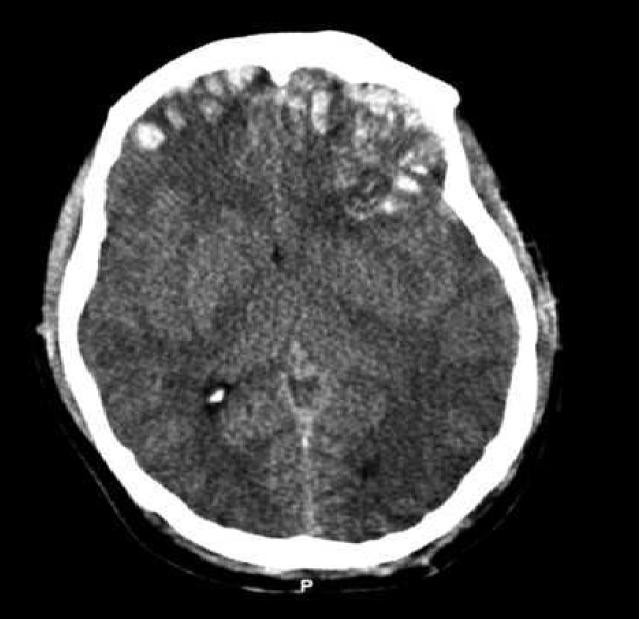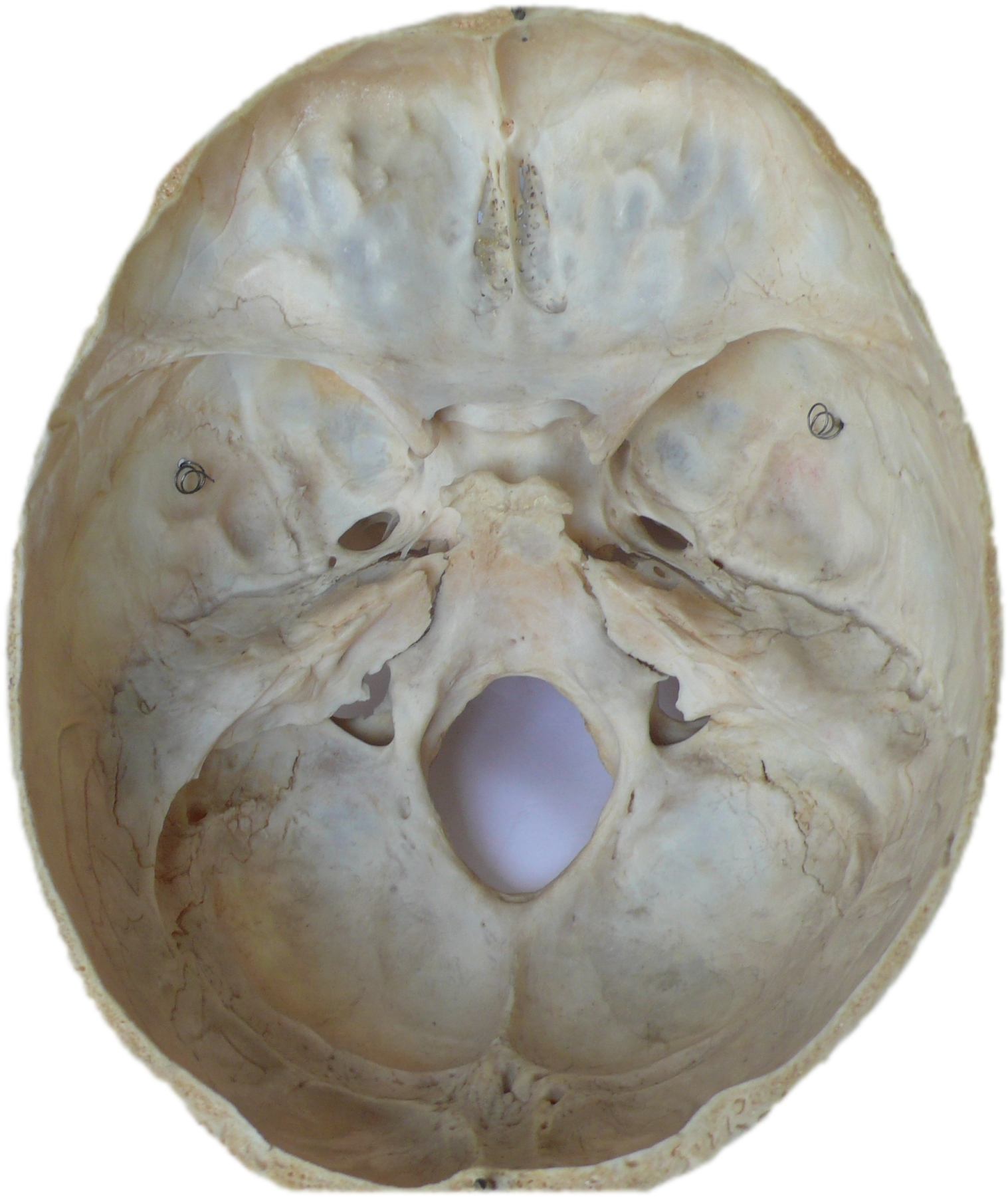Cerebral contusion
| Cerebral contusion | |
 | |
|---|---|
| CT scan showing cerebral contusions, hemorrhage within the hemispheres, subdural hematoma on the left, and skull fractures[1] | |
| ICD-10 | S06.2, S06.3 |
| ICD-9 | 851 |
Editor-In-Chief: C. Michael Gibson, M.S., M.D. [1]
Overview
Cerebral contusion, Latin contusio cerebri, a form of traumatic brain injury, is a bruise of the brain tissue. Like bruises in other tissues, cerebral contusion can be caused by multiple microhemorrhages, small blood vessel leaks into brain tissue. Head CT scans of unconscious patients reveal that 20% have hemorrhagic contusion.[2] Contusions are likely to heal on their own without medical intervention.[3]
Signs and symptoms
Contusion can present with weakness, lack of motor coordination, numbness, aphasia, and memory and cognitive problems.[4] Signs depend on the contusion's location in the brain.[4]
Causes

Often caused by a blow to the head, contusions commonly occur in coup or contre-coup injuries. In coup injuries, the brain is injured directly under the area of impact, while in contrecoup injuries it is injured on the side opposite the impact.
Contusions occur primarily in the cortical tissue, especially under the site of impact or in areas of the brain located near sharp ridges on the inside of the skull. The brain may be contused when it collides with bony protruberances on the inside surface of the skull.[5] The protuberances are located on the inside of the skull under the frontal and temporal lobes and on the roof of the ocular orbit.[6] Thus, the tips of the frontal and temporal lobes located near the bony ridges in the skull are areas where contusions frequently occur and are most severe.[7] For this reason, attention, emotional and memory problems, which are associated with damage to frontal and temporal lobes, are much more common in head trauma survivors than are syndromes associated with damage to other areas of the brain.[8]
Features
Contusions, which are frequently associated with edema, are especially likely to cause increases in intracranial pressure (ICP) and concomitant crushing of delicate brain tissue. Contusions are also more likely to result in hemorrhage than is diffuse axonal injury because they occur more often in the cortex, an area with more blood vessels.[9]
Contusions typically form in a wedge-shape with the widest part in the outermost part of the brain.[10]
Multiple petechial hemorrhages
Numerous small contusions from broken capillaries that occur in grey matter under the cortex are called multiple petechial hemorrhages or multifocal hemorrhagic contusion.[9] Caused by shearing injuries at the time of impact, these contusions occur especially at the junction between grey and white matter and in the upper brain stem, basal ganglia, thalamus and areas near the third ventricle.[9][2] The hemorrhages can occur as the result of brain herniation, which can cause arteries to tear and bleed.[9] A type of diffuse brain injury, multiple petechial hemorrhages are not always visible using current imaging techniques like CT and MRI scans. This may be the case even if the injury is quite severe, though these may show up days after the injury.[2] Hemorrhages may be larger than in normal contusions if the injury is quite severe. This type of injury has a poor prognosis if the patient is comatose, even with no apparent causes for the coma.[2]
Cerebral lacerations
A cerebral laceration occurs when the tissue of the brain is mechanically cut or torn.[11] Lacerations require greater physical force to cause than contusions,[11] but the two types of injury are grouped together in the ICD-9 and ICD-10 classification systems.
Frequently occurring in the same areas as contusions, lacerations are particularly common in the lower part of the frontal lobes and the tips of the temporal lobes.[11] When associated with diffuse axonal injury, the corpus callosum and the brain stem are common locations for lacerations.[11] Lacerations are very common in penetrating and perforating head trauma and frequently accompanying skull fractures, but do not require skull fractures to form.[11] Lacerations, which may occur when brain tissue is stretched, are associated with bleeding.[11]
Cerebral contusion
{{#ev:youtube|_SKgZg8PYbI}}
See also
- Traumatic brain injury
- Brain damage
- Concussion
- Diffuse axonal injury
- Intracranial hemorrhage
- Intraparenchymal hematoma
- Epidural hematoma
- Subdural hematoma
- Subarachnoid hemorrhage
References
- ↑ Rehman T, Ali R, Tawil I, Yonas H (2008). "Rapid progression of traumatic bifrontal contusions to transtentorial herniation: A case report". Cases journal. 1 (1): 203. doi:10.1186/1757-1626-1-203. PMC 2566562. PMID 18831756.
- ↑ 2.0 2.1 2.2 2.3 Downie A. 2001. "Tutorial: CT in Head Trauma". Retrieved March 16, 2007
- ↑ Sanders MJ and McKenna K. 2001. Mosby’s Paramedic Textbook, 2nd revised Ed. Chapter 22, "Head and Facial Trauma." Mosby.
- ↑ 4.0 4.1 Kushner D (1998). "Mild Traumatic Brain Injury: Toward Understanding Manifestations and Treatment". Archives of Internal Medicine. 158 (15): 1617–1624. PMID 9701095.
- ↑ Rao V, Lyketsos C (2000). "Neuropsychiatric Sequelae of Traumatic Brain Injury". Psychosomatics. 41 (2): 95–103. PMID 10749946.
- ↑ Shepherd S. 2004. "Head Trauma." Emedicine.com. Retrieved on 2008-01-10.
- ↑ Graham DI and Gennareli TA. Chapter 5, "Pathology of Brain Damage After Head Injury" Cooper P and Golfinos G. 2000. Head Injury, 4th Ed. Morgan Hill, New York.
- ↑ Bigler, ED. 2000. The Lesion(s) in Traumatic Brain Injury: Implications for Clinical Neuropsychology. Accessed through web archive. Retrieved on 2008-01-17.
- ↑ 9.0 9.1 9.2 9.3 Template:Medcyclopaedia
- ↑ Vinas FC and Pilitsis J. 2006. "Penetrating Head Trauma." Emedicine.com. Retrieved on 2008-01-10.
- ↑ 11.0 11.1 11.2 11.3 11.4 11.5 Hardman JM, Manoukian A (2002). "Pathology of Head Trauma". Neuroimaging Clinics of North America. 12 (2): 175–187, vii. doi:10.1016/S1052-5149(02)00009-6. PMID 12391630.
Template:Injuries, other than fractures, dislocations, sprains and strains